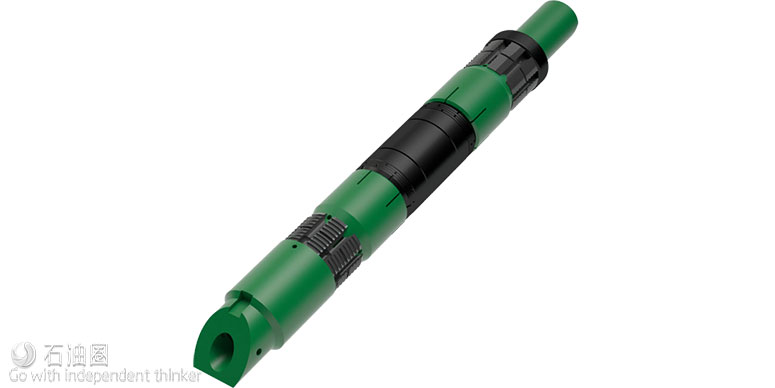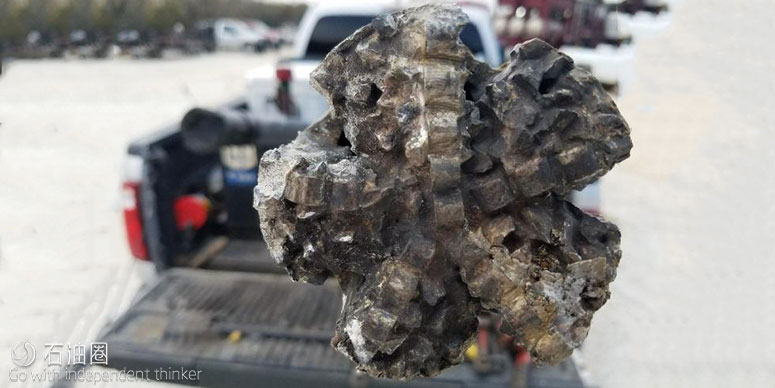Magnum Oil Tools’ Long Range fracture plugs have been run more than 9,800 times in wells worldwide.
The genesis of Magnum Oil Tools International Ltd.’s Long Range fracture plug was in the late summer of 2010, which in unconventional oilfield years is a lifetime ago.
The initial plug application—as covered in detail in the Society of Petroleum Engineers paper 146559, “A Unique Plug for a Restricted Wellbore”—was used in a West Texas well to provide zonal isolation for stages three through eight. After sticking three 3.92-in. fracture plugs in the hole (including one run on coiled tubing), a caliper run showed no signs of a restricted inside diameter (ID). The issue was a combination of a pin connection that could potentially cause a plug and tool string to be hung up, the wellbore’s P-trap-like trajectory, and a dogleg severity would prevent anything greater than 1.8 m (6 ft) with an outer diameter (OD) of 3.65 in. from getting past 1,981 m (6,500 ft) of measured depth (MD).
Magnum developed a 3.25-in. OD slimhole plug that would set and hold 7,500 psi in 5-in. 18-lb/ft P-110 casing. Not only was the first plug deployment successful, all subsequent runs were made without issue, allowing the operator to complete the well.
Development
Since its release, Magnum’s Long Range fracture plug has been run more than 9,800 times worldwide, saving operators time and opex. Prior to a reliable slimhole plug being on the market, completions teams were left with subpar options once casing had been repaired or a highly deviated well was handed over. This was the case especially if either or both of these restrictions were above a portion or all of the zones to be completed.
In some cases, the successful application of a sand “plug” has been documented. Rather than flushing the end of each stage, the zone is pumped with an excess amount of sand to plug off the newly fractured formation. The cost effectiveness of this practice, as well as the reliability of a nonmechanical barrier to truly isolate zones, is debatable. Although slimhole plugs were around for a decade or more prior to Magnum’s Long Range, they were lacking several fundamental features that prevented the products from being economical—even in the days of $70/ bbl to $100/bbl oil.
In many cases, the plugs designed for vertical wells were found to be inadequate for horizontal plug-and-perf operations. Getting pumped to bottom through a casing restriction and the plug set were a roll of the dice. The initial slimhole plugs used were typically made from cast iron, or even in some cases stainless steel, which all but prevented them from being drilled out without costly delays.
With Magnum’s Long Range, there is a customizable and reliable way to complete wells with casing restrictions, casing parts and severe doglegs. Furthermore, since the Generation One Long Range was made from composite material, aluminum and utilized cast iron slips, multiple plugs could be drilled out in a single trip, with an average mill-out time of 45 minutes per plug.
The caveat of any restricted wellbore plug drillout is that one must use an undersized, drill-out, bottomhole assembly (BHA) to fit through the restriction. This limitation is the largest contributor to the lengthy drill-out times. To combat this limitation, careful consideration should be taken in the selection of the BHA used. Experience dictates the best option for drilling out an aluminum and composite plug is a five-blade reverse clutch junk mill. Using a reverse clutch prevents the mill from locking up, and the mill face allows the plug to be broken up into manageable pieces.
Second-generation plug
Looking to improve upon the drill-out times per plug of the Generation One Long Range, Magnum prototyped and began field trials in early 2014 of the Long Range Generation Two plug. This plug provided the same pressure and temperature capabilities of the Generation One but also utilized 75% less aluminum. By accomplishing this, Magnum was able to reduce the drill-out times per plug by half.
As described in Case Study LR-16 on the Magnum Oil Tools website, the eight stages that were completed below the casing patch not only incurred zero plug failures during the completion, the plugs were drilled out in an average of 22 minutes each. This millout also utilized the recommended five-blade reverse clutch junk mill.
In more recent cases, likely due to the advancements in bit technology, Magnum Canada has seen success with drillouts that utilize a tri-cone bit. In May 2017 Magnum Canada was on a 37 Long Range plug drillout. The depths of the 3.75-in. OD Long Range Generation Two plugs ranged from 2,999 m (9,842 ft) to 5,499 m (18,044 ft) of MD in 5.5- in. 26-lb/ft casing.
The casing ID was 4.548 in. and had a 3.996-in. ID liner. The liner was set at 718 m (2,357 ft) and was 6 m (20 ft) long. The first 13 plugs were milled out with a five-blade reverse clutch junk mill and averaged 68 minutes per plug. The mill was pulled out of the hole and replaced with a 3.976- in. OD tri-cone bit. The remaining 24 plugs were drilled out with an average time of 28 minutes per plug.
In addition to reducing the average drill-out time per plug, the Long Range Generation Two plug has been run in challenging wellbores. With sizes ranging from a 3.06-in. to 3.92-in. OD, the plug successfully holds at 10,000 psi and 148 C (300 F).
In the spring of 2016, an operator in the Rocky Mountains was having an issue with a completions system that required casing restrictions that were preinstalled with the casing. Rather than rerun casing, the operator called on Magnum to run 153 Long Range Generation Two plugs in the 3.06-in. OD size. The operator was able to salvage its completions and simultaneously create more options for stage spacing. All plugs were run through the aforementioned casing restrictions with no issue.
The E&P sector continues to be driven by engineering, specifically within completions departments. With that, the applications for solid expandable liners and casing patches will continue to become more creative and cost effective. Wells that were once left to be plugged and abandoned are regularly completed to their full potential because of this technology and ingenuity of the end users. Advancements in zonal isolation are no different.

 石油圈
石油圈

